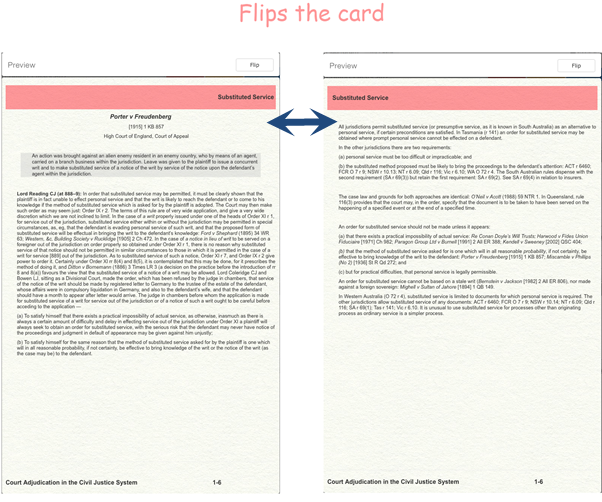
Stephen Colbran [1], Anthony Gilding [2] & Samuel Colbran [3]
Cite as Colbran S., Gilding A. & Colbran S., "The role of digital flashcards in legal education: theory and potential", in European Journal of Law and Technology, Vol 5, No 1, 2014.
This article describes, evaluates and reflects upon the potential use of digital flashcards in legal education using traditional cards expressed in digital format and more interactive flashcards taking advantage of rich media and Web 2.0 technologies. A taxonomy of digital flashcards is proposed together with a discussion on how flashcards may be used in legal education. An analysis of where digital flashcards sit within the HoTEL, Biggs and Tang SOLO and Atkinson SOLE learning theory frameworks is presented. A new free cloud-based flashcard tool, FlashCram is outlined enabling the easy assembly and sharing of digital flashcards. The article concludes by showing how the traditional flashcard may be reinvented in the digital age into a useful tool for legal education. [4]
Keywords: Flashcards, student directed learning, authentic learning, online student flashcards, legal education, mobile education, flashcard taxonomy, HoTEL framework. SOLO, SOLE
For many years academics have been designing learning activities and assessment tasks enabling students to learn through making [5] artefacts or engage in learning by doing. [6] These learning experiences are often informed by constructionism [7] and social views of learning. [8] Put simply, when we discuss and build an artifact, we learn something about it.
Web 2.0 or Participatory Technology [9] continues to afford new learning opportunities to support collaborative teamwork enabling construction of learning artifacts for individual or collaborative use. According to Farkas,
Web 2.0 was built on an 'architecture of participation,' where users are both consumers and producers of information …[and] tools for participation became easier to use. When sharing knowledge and media is easy as typing words into a box or clicking a button, it becomes something everyone with Internet access can do. [10]
Technologies such as Google Docs, [11] YouTube, [12] and Zoom [13] may assist students to 'master new knowledge and skills, critically examine their existing assumptions and beliefs, and engage in an invigorating, collaborative quest for wisdom and personal, holistic development'. [14] Web 2.0 provides an opportunity to reexamine the design of traditional two-sided printed flashcards in ways that allow for greater collaboration and sharing of digital artifacts.
Similarly mobile technologies provide access at any time and connections between students, staff and others. These technologies further enhance the ability for teamwork and collaborative learning to build learning artifacts. It is essential that any digital flashcard approach to learning is able to integrate with a wide variety of digital devices, many of which are mobile devices.
Digital Flashcards provide a further opportunity to revisit old learning activities from a new, and potentially exciting perspective. Like many Web 2.0 technologies, digital flashcards allow students to individually or collaboratively build a range of artifacts, or simply use those developed by others in different learning contexts. While the building of a pack of digital flashcards may not be quite as simple as 'clicking a button", the Web 2.0 application known as FlashCram developed by the third author and described in this article dramatically simplifies the construction and sharing of digital flashcards.
Traditional flashcards have long been a part of undergraduate law students' repertoire of learning resources. Numerous examples of law related flashcards may be seen on the internet, both developed by students [15] and commercial publishers. [16] Digital flashcards provide new possibilities for learning about the law beyond simply memorisation of legal facts.
Hermida (2006), when speaking about Canadian Law Schools observed, 'Law School curricular, with its teaching philosophy built during an exclusively print-centered era, has not yet opened its doors to audio-visual teaching methodologies or to media literacy.' [17] Aside from Microsoft PowerPoint only a handful of tentative steps have been made in Australian Law Schools towards audio-visual teaching methodologies, multi-media literacy and a visual pedagogy. [18] Instruction is often lecturer and print-centered. 'The teaching methods do little, if anything, to encourage students to create and produce their own (and collective) legal texts and knowledge, whether media centered or not.' [19]
Hermida (2006) [20] observes:
Visual pedagogy advocates the teaching of media literacy across the curriculum, [21] and as part of a plan that is sensitive to the diverse concerns, knowledge, and experiences of students. [22] Media literacy has been conceptualised as the 'the process of critically analyzing and learning to create one's own messages - in print, audio, video, and multimedia, with emphasis on the learning and teaching of these skills through using mass media texts'. [23] It includes the cognitive and affective processes involved in viewing and producing audio-visual materials.
Ronahoe (2010) [24] from her observations of Georgetown University Law, digital law students, observes:
Taking notes and watching PowerPoint slides are passive activities that do not engage these students. [25] Text alone often bores digital students. [26] Multimedia, such as computer graphics, video and animation, will help engage digital students by bringing material to life and helping them understand the context and relevance of the material to the "real world." However, students need even more. They need their learning to be three-dimensional-not flat, linear or purely textual. They need interactivity where their minds (and screens) are turned on and working in overdrive. They need to become a part of the material through collaboration, interactivity, and simulation. [27]
Digital students also crave peer review and interaction. Collaboration is at the heart of learning for them. Learning is a social phenomenon as well as a cognitive process. [28] By bouncing ideas off of each other, students can formulate their own opinions and drive the discussion themselves. They enjoy learning through discovery and discussion. [29] Their collaboration can either be in class, in person or virtual. [30] As a result, the professor no longer needs to be the sole and center point of learning; instead students have many resources from which to choose. Digital students often set up blogs for specific issues. They also e-mail and IM each other often (usually in the middle of class).
There is clearly scope for a digital literacy in studying the law. In general, Herrington argues that:
The preferred approaches are those that encourage and support deep rather than surface approaches to learning (Ramsden, 1992). The majority of these approaches are based on learning strategies that promote knowledge construction and include such forms as problem-based learning, computer-supported collaboration, and student-centered learning. [31]
In this article, we discuss one Web 2.0 tool that was originally developed to support investigation into the concept of digital flashcards, [32] their development and use in undergraduate legal education.
Flashcards traditionally have been defined as a card 'with words etc., shown briefly to a child by a teacher as an aid to learning'. [33] There are several assumptions inherent in this definition, namely a physical card, with something appearing on it, shown to children, by a teacher, as an aid to learning.
Flashcards do not have to physically exist as a card - they can exist in electronic form resembling a card. What appears on a flashcard traditionally would have been writing, perhaps even a drawing or image. In digital flashcards this can be extended to include animation, movies, audio, music, social networking and a multitude of interactive elements. Flashcards are not only for children, they are for anyone. It is incorrect to assume that teachers control the use of flashcards as it is common for flashcards to be created by learners themselves or in collaboration with one another. Flashcards may be considered not only as an aid to learning, but can be an aid to memory, recall, collaboration, as well as a tool for formative and summative assessment. What we can observe from this brief analysis is that the traditional definition of a flashcard is unduly restrictive.
Flashcards are traditionally two sided - front and back. The front of a flashcard displays information and often a question or exercise, with an answer provided on the back of the flashcard. Users read the card and formulate a response, which is then compared with the response on the back of the flashcard, thereby providing immediate formative feedback. The process enables users to determine whether they remember and understand the concepts depicted in the flashcard.
Flashcards may be extended to three sides with the introduction of a hint. Digital flashcards can also incorporate data such as user or academic defined levels of complexity, or complexity assigned by user error rates. Flashcards can be truly multi-dimensional. Both printed and digital flashcards may be combined with a system for staged repetition as an aide to memory retention.
Flashcards are commonly created and shared amongst people seeking to test their knowledge and memory. The process of construction of the flashcards promotes learning by doing, critical analysis and synthesis of information. Revision with flashcards promotes formative assessment and self-identification of misinterpretations and memory faults, which may in turn be corrected through self-reflection. Sharing of cards also affords the opportunity for peer review.
This article explores new possibilities for digital flashcards, their construction and use in legal education.
There are many possible classification schemes for legal flashcards. For example, a scheme may be developed to represent particular sub-disciplines, e.g. Contract Law or Tort. Another approach is to focus on the structure, composition and relationships between cards. In contrast to these approaches our flashcard classification scheme is influenced by different aspects of legal content being represented, the role the card may have in learning about the law, the capacity to include rich media and features of Web 2.0 technologies itself.
The following taxonomy may evolve further with our experience using the FlashCram tool with law students. The different types of cards include:
The taxonomy of cards does not represent mutually exclusive categories. For example one card may combine elements of different types of cards. Similarly cards may link together in threads within and across packs of cards associated with different legal topics. The implications of each type of card and their interrelationships have implications for the learning theories or practices digital flashcards may support which is examined later in this article.
Not all flashcards are created equally. Cards that simply summarise and test concepts are relatively simple to create, e.g. case and legislation cards. Cards that involve sequencing of numerous cards (e.g. flowchart card) involve more work and complexity. Cards that operate outside their four corners (e.g. interview card, gaming card, social networking cards) require more preparation by both academics and students alike, with varying degrees of collaboration. Some cards (e.g. polling cards, mind mapping and wiki cards) will require additional software experience to set up. In any event it is important to note that flashcards may be created by academics, or students or both.
Having defined the types of digital flashcards relevant to law, we will now consider a tool with which to develop them.
FlashCram is purpose built cloud-based software enabling the easy assembly and sharing of digital flashcards. The FlashCram software was developed by the third author using PHP and mySQL and is available from www.flashcram.com. HTML editing functionality is provided by a modified version of the tinymce javascript library. FlashCram is not the only available tool. Wikipedia [34] has a useful comparative table of numerous other flashcard systems. FlashCram was selected as it was free, uses current software engineering frameworks, runs on all commonly used mobile devices and can be supported by the project team.
Digital flashcards resemble their print based origins as shown in the Fig 1 Case card below. One side, containing a question is presented to the student. The student may then click a "flip" button to reveal the other side of the card.

Fig 1. Two sides of a Case card
Digital flashcards may provide many other options beyond a simple question and answer. One challenge for both students and teachers is to move beyond text based design principles used for printed cards to embrace additional interactive and collaborative elements afforded by Web 2.0 mobile technologies.
FlashCram allows for the building of packs of digital flashcards. In the example below, there are two packs of cards developed by the owner of the account. However, on this occasion the owner is collaborating with others on a further four packs of flashcards. In FlashCram it is easy to have other collaborators assist with the development of a pack of cards.
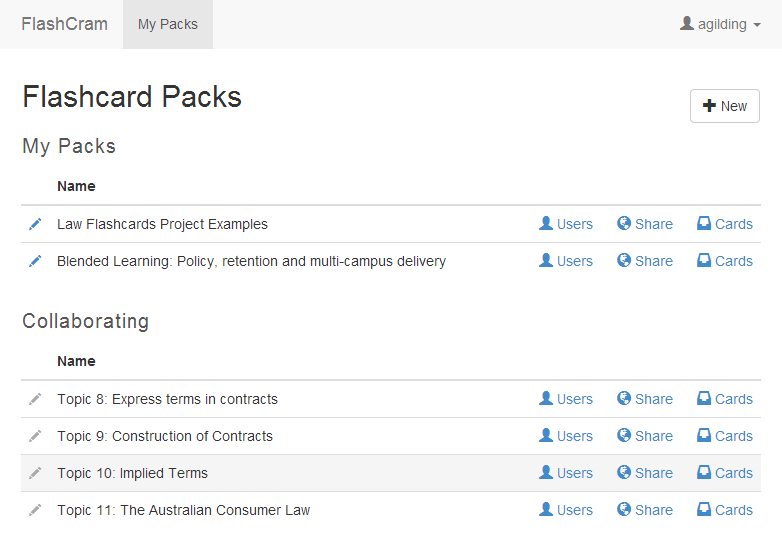
Fig 2. Flashcard packs view of Flashcram
FlashCram has a familiar interface. [35] Drop down menus and specific buttons allow for the user to perform the same operation in different ways. The interface is similar to a common word processor or HTML editor. Figure 3 displays many of the features of the editor.
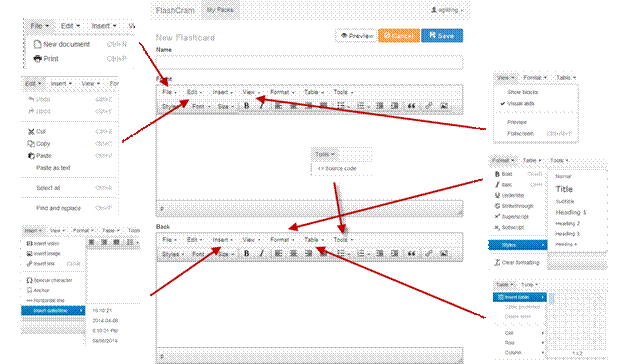
Fig 3. Flashcram editor screen used to develop a digital flashcard
FlashCram affords collaboration between users by enabling sharing and editing functions between collaborators. Complete digital flashcard packs can then be made available for viewing, but not editing, by anyone knowing the unique ID for the flashcard pack.
Traditional printed flashcards are often numbered sequentially to ensure the integrity of the pack of cards such that they can be easily reordered if out of sequence. Similarly digital flashcards need not be isolated from one another, but may contain links that form a network of digital flashcards of varying degrees of complexity. The following paragraphs explore some of the possibilities.
Digital flashcards may be created such that the sequencing between cards is unimportant. For example a pack of cards may consist of a series of questions and answers on a selected topic. The questions may be undertaken in any order without breaching the integrity of the revision process. Random cards are best suited for revision rather than instruction on a topic, which of necessity would require some sequencing in the development of topics.
Sequenced cards make sense by requiring users to follow a particular order or path. In traditional paper cards, integrity may be maintained by sequencing of numbered cards.
A simple linear sequence of one card following another creates an ordered sequence of topic exploration. A slightly more complex version enables branching within a sequence, as shown in Fig 4. The branches themselves may involve simple linear sequencing or further branching.
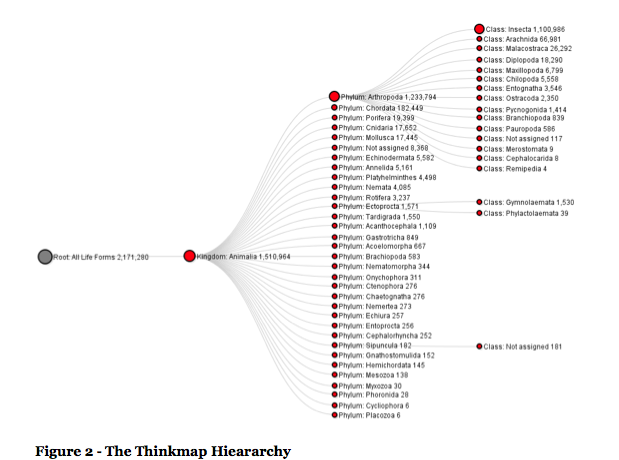
Fig 4. Simple branching [36]
Digital flashcard networks may exhibit several degrees of complexity. In their simplest form they represent hyper-texted linkages between cards within or between card packs. Examples of this include simple flipping of cards and linear sequenced links between cards. More complex forms include concept maps for overall topic orientation combined with packs of cards related to the selected topic - See Fig 5 and 6. Cards may also have links across different packs, where concepts have interconnections between different areas of the law.
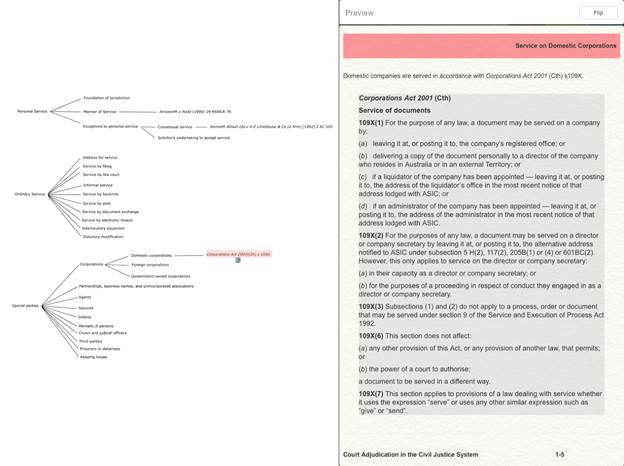
Fig 5. FlashCram legislation card with an associated card map
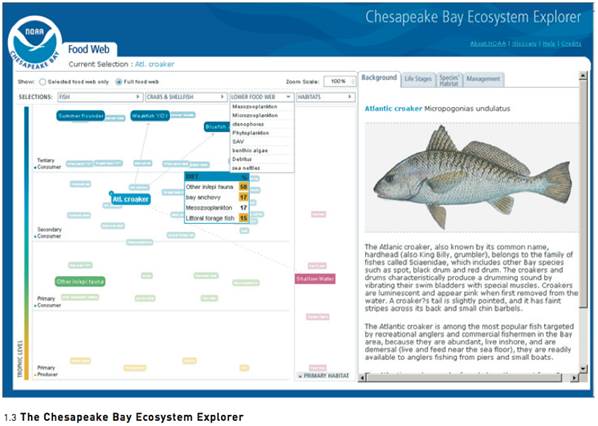
Fig 6. ThinkMap example - The Chesapeake Bay Ecosystem Explorer [37]
Card networks can also be presented as time series data as shown in figure 7. It would be possible for example to map out the development of legal principles through the cases, legislation, and secondary materials over time, as well as documenting their interrelationships. The same methods could also be used for documenting and managing complex files. The graphical representations can then be used for an interactive investigation of the associated topics. These are examples of quite advanced systems requiring considerable legal and technical abilities to implement.
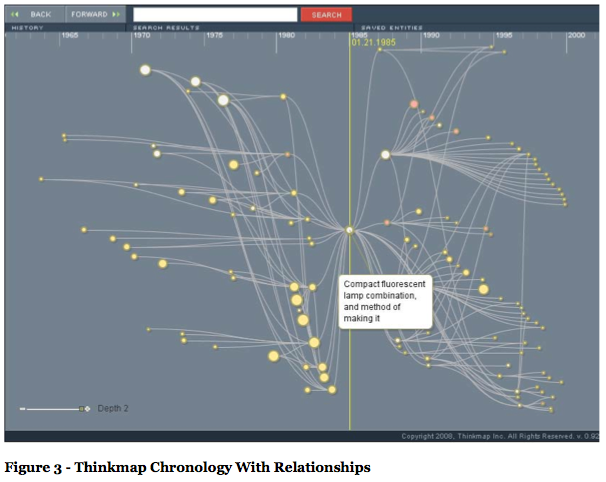
Fig 7. Thinkmap Chronology with Relationships [38]
Digital flashcards may have several valuable data streams associated with them. Examples include:
Path analysis - how users travel along the card network, identifying where bottlenecks arise.
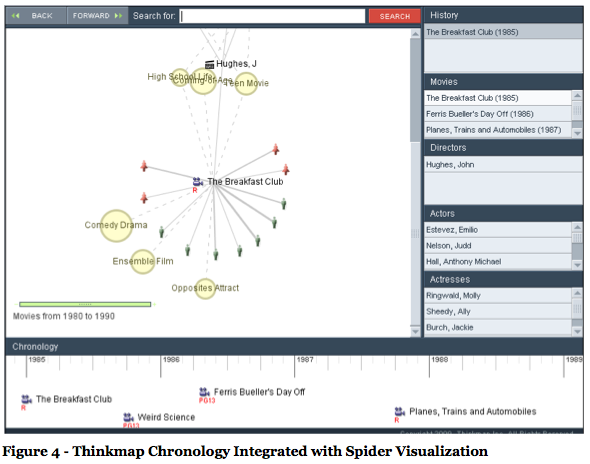
Fig 8. Thinkmap Chronology integrated with spider visualization
Digital flashcards enable a variety of representations of assembled information connected in different ways. Building a flashcard and assembling a basic network of flashcards is relatively easy once a student decides on the information and/or process to be expressed in the flashcards and their sequencing.
Consistent with Web 2.0 technologies, students have considerable autonomy and may create their own learning community, aggregating information in different ways to assist their individual and collective reflection and learning processes. Making the production, connection between and sharing of flashcards easier and more accessible allows us to learn with flashcards in ways beyond simple memorising legal facts and cases. Digital flashcards may be used in learning activities inspired by a range of learning theories. In this section we consider the versatility of digital flashcards by examining:
The display of learning theories [41] developed in the Holistic Approach to Technology Enhanced Learning (HoTEL) [42] project reminds us of the range of learning theories available. Whilst this display was developed primarily for secondary education and therefore has some omissions with regard to higher education, we believe it is useful to remind us of the range of learning theories that often inform our practice. The diagram provides a view of these theories from an altitude that emphasizes the diversity of learning theories available together with one or two of key differences that separates them.
We will use elements of the HoTEL display of learning theories to explore different ways in which digital flashcards may support learning, This is particularly important as digital flashcards and representations of the relationships between aggregations of those flashcards opens up many new possibilities for legal education.
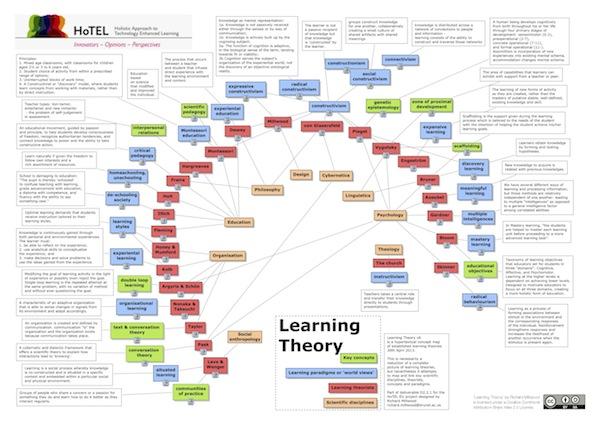
Fig 9. HoTEL Learning Theories
Flashcards may be developed in any one or more combinations of three processes:
We believe flashcards may be used to support the following learning activities derived from a range of learning theories depicted in the HoTEL framework including:
When we reflect on the taxonomy of digital flashcards in the context of generic educational design models, we see different types of cards aligning with different creative levels of learning outcomes. In the following example, flashcards are mapped to the Biggs and Tang SOLO constructive alignment model. [60]
The SOLO taxonomy maps student's work in five phases: from incompetence (Prestructural), through a single and then multiple understandings of a topic (Unistructural and Multistructural), to the ability to interconnect ideas and elements of a task (Relational) and finally (Extended Abstract) extending a complete understand the topic into new domains. Each phase involves increased cognitive load.
Each type of flashcard described in our taxonomy has different characteristics helping to align them to the Biggs and Tang model. For example case, legislation, principle, secondary source and Q & A flashcards focus on a single aspect of a case or legislation and in that light are unistructural. The limited size of each flashcard promotes a concise analysis of the issue discussed. This chunking of information assists with memory acquisition and retention. A unistructural approach is also involved with the simple procedure of a timeline card and an image card that captures and names a single aspect of knowledge. If any of these cards consider multiple relevant aspects then they transition into a multistructural phase.
Several flashcards are inherently multistructural, in the sense that they involve serial tasks. An audio-visual card for example may require, the construction of content, the linking to, playing and listening to audio-visual data. An interview card involves preparation, conduct, recording and embedding of text or audio-visual material arising from an interview. A simple gaming card involves branching structures and outcomes. A mosaic card requires a combination of several cards to describe a greater whole, a larger concept or perhaps a list. All these flashcards involve the performance of serial tasks. They have set procedures including multiple relevant aspects, but they are not relational or inter-related. If they acquire that latter aspect they move into the relational phase.
Relational cards display multiple inter-related aspects. They have distinct features. For example a polling card analyses, compiles, compares and contrasts user opinions. A conundrum card requires students to analyse a situation, criticise, explain causes and effects, relate and justify a position. A comparison card also engenders these features, particularly comparison and contrast. Social-networking cards and discussion cards relate concepts, criticisms, opinions, justify positions, argue positions etc - all involved with the relational phase. The flowchart card can also demonstrate multiple inter-related aspects, particularly if it involves user choice branching down alternative paths through a card network. A simple flowchart with a defined path may be more multistructural than relational. Finally the practical application card in the form of a case study can support the development of relational aspects through analysis, critique and discussion.
A reform card enables students to apply their knowledge to a new domain, which actively promotes an extended abstract phase. Both the reflection card and the reform card involve the creation and formation of new information at the highest end of the SOLO model. There will be elements of hypothesis formation, reflection and development of new theories. While these cards are not technically difficult to construct using FlashCram, the degree of legal skill and knowledge required makes these tasks difficult and at the higher end of cognitive load.
At best, the above analysis only reflects rough positionings, as flashcards may transcend various levels of the SOLO model.
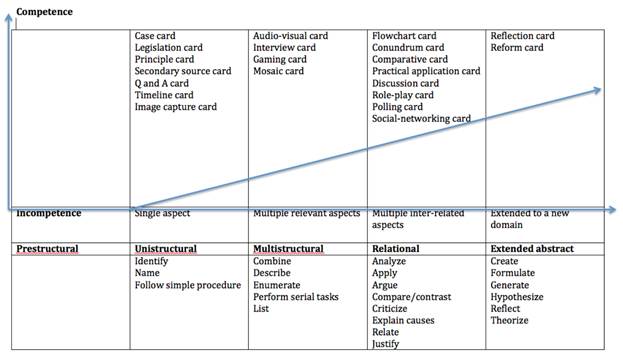
Fig 10. The Taxonomy of digital flashcards mapped against the Biggs and Tang model indicating increasing levels of cognitive load
Based on the authors' experience in flashcard creation, Fig 11 depicts the level of technical effort required to create each card type against the SOLO levels. Figure 11 does not reflect the legal analytical effort involved in each type of card as that will vary with the subject matter.
|
High technical effort
Low technical effort |
Image capture card Timeline card Q & A card Case card Legislation card Principle card Secondary source card |
Gaming card Audio-visual card Interview card Mosaic card |
Polling card Flowchart card Social networking card Role-play card Discussion card Conundrum card Comparative card Practical application card |
Reform card Reflection card |
|
Prestructural |
Unistructural |
Multistructural |
Relational |
Extended abstract |
|
Identify Name Follow simple prcedure |
Combine Describe Enumerate Perform serial tasks List |
Analyze Apply Argue Compare/contrast Criticize Explain causes Relate Justify |
Create Formulate Generate Hypothesize Reflect Theorize |
Fig 11. Flashcards linked to SOLO and level of technical difficulty in creation
Digital Flashcards may also be used to support many of the elements of the Atkinson (2012) SOLE model as shown in Fig12. [61] SOLE stands for student-owned learning-engagement. Students who are conscious of the learning design and the flashcard learning process may optimise their learning engagement either individually or collaboratively in the creation and sharing of flashcard artifacts. Atkinson argues that,
These nine elements of the SOLE model are designed to reflect a comprehensive consideration of the students' learning experience which, if properly populated, would afford an effective balance of activity, learning ownership, and opportunities for higher-order thinking and deep learning. [62] In Fig 12 the highlighted blades are particularly relevant to flashcards.
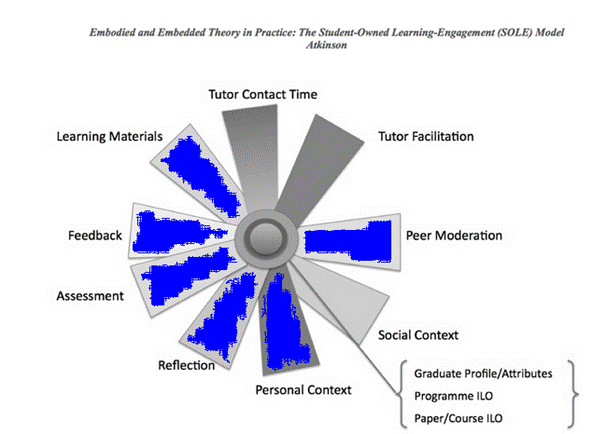
Fig 12. The Atkinson SOLE model 2012 [63]
Digital flashcards may provide self-generated, peer-generated or teacher-focussed feedback and may be used to support both formative and summative assessment. Digital flashcards may support reflection-on-action to reflection-in-action processes as a course progresses. Real-world activities may be brought into the learning design through incorporation into digital flashcards of individual life experience and context. The design of digital flashcards may also engage with and bring in a social context into a course design. For example reflections on personal experiences and interfaces with the law can include indigenous and cross-cultural perspectives. The sharing and collaborative construction of digital flashcards may include peer moderation, critique and inquiry. Tutors may facilitate the construction and sharing of digital flashcards whether as an individual or collective exercise. Tutor contact time, whether face-to-face, virtual (synchronous or asynchronous) may have an impact on the quality of digital flashcards. These types of learning artifacts may potentially provide a rich seam of materials in which to support domain knowledge acquisition, whether created by academic staff or even more so if constructed and shared by the learners themselves.
Flashcards have traditionally been used to enhance the retention of information through both the development of the card and through repetition of card content. For example, a flashcard may ask students to recollect the elements of a contract, a sequence of steps involved in deciding whether to disclose a document in a litigation etc. The student will compare their response with that on the reverse side of the flashcard or materials linked from the flashcard. The primary purpose is formative assessment to reinforce memory and relationships between legal concepts.
Flashcards are often associated with spaced repetition enabling the systematic testing of one's own knowledge. The Leitner system [64] is designed to enhance memory retention. In the Lietner system, flashcards are grouped into packs of increased levels of memory retention - or current levels of knowledge. Correct answers progress a flashcard to a higher-level pack, incorrect answers revert a flashcard to the lowest level pack. Common systems have five levels of flashcard packs. Lower level packs are reviewed more often than higher level packs, e.g. pack 1 - 1 day review cycle; pack 2 - 3 days; pack 3 - 7 days; pack 4 - 15 days; pack 5 - 20 days. As the information is committed to memory and user responses are accurate all flashcards would move to the 5th level as it is inefficient to frequently repeat information you have already mastered. The order of flashcards and the spacing of their display is designed to optimise memory retention by focussing attention on flashcards in which the user responses contain errors or misunderstandings. Groupings may be based on automated marking of cards - e.g. based on multi-choice or pre-set answers - or may be set by the user as they review their response to a card. A user may perceive a particular concept or task as difficult requiring more repetition to be understood and memorized. Hence the flashcard should be placed in pack 1 on a more frequent repetition cycle.
Leitner systems, while traditionally print based, have in recent times been recreated in a digital flashcard environment. Users may specify the number of flashcard boxes and also the sequencing of the spaced repetition. More complex algorithms may be implemented, that adjust to determine the optimum rate of repetition for each individual learner's memory retention.
Data analytics may be used to determine the branching paths associated with card networks. In the same way that memory lapses may result in cards being assigned more repetition in the Lietner system, errors in response to cards may result in:
Data analytics may assign extension or remedial work for individual student development. Error rates associated with cards may be tabulated for individual users, such that remedial or extension cards may be assigned. Cards may include a traffic light system (red, yellow and green) indicating to students the level of difficulty of a card based on cohort experience and error rates associated with that flashcard.
Data analytics may identify areas or paths of collective cohort difficulty. Error rates associated with cards can be tabulated not only for individual users, but cohorts of users, so that a difficulty profile of a particular flashcard, type of flashcard, or sequencing of flashcards may be compiled. This information may enable academics to consider redesigning the flashcard or other methods of instruction related to that concept to improve student comprehension and memory retention.
Card networks may also be designed to enable experiments. For example, randomly assigned student cohorts may be assigned defined cards or paths through card networks with retention and ultimate results compared.
Data analytics in the form of path analysis through card networks may be represented either by colour or size, or both. Areas in card networks that are causing issues for the student cohort as a whole may be easily identified. These bottlenecks may be analysed to determine whether course revision is required. Revisions may be made and the effects observed in real time. Reports on student success or otherwise can be easily accessed and generated.
Flashcards may also be modelled as games. A simple example of this can be seen with Cram.com illustrated below. [65] Games have the potential to make memory recollection and application fun and challenging for individuals or a competitive exercise between individuals.
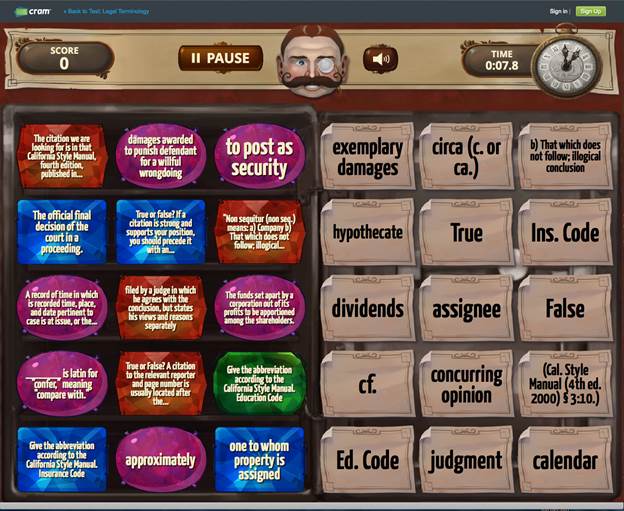
Fig 13. Game composed of flashcard questions
The linking of flashcards with navigational mapping as shown in figures 4-8 allows academics and students alike to construct and share cloud-based educational systems for legal topics. Users may break and relink sequences of cards. New cards can be easily added into sequences or as entirely new topics. Old cards may be deleted or reorganised using a mind mapping construct. Data analytics can automatically follow the amended sequences providing useful diagnostic tools associated with student learning.
Digital flashcards provide an opportunity to teach law in different way. A Web 2.0 cloud-based environment may provide an opportunity to build participatory tools that make it easier for students to use, build share representations of aspects of the law beyond what may be achieved in print based cards or desktop applications. Flashcards also offer the additional affordance of offering a method for memory retention - the Leitner model - or other more complex approaches.
Reconceptualising flashcards in a Web 2.0 environment opens up many possibilities such as visual schemes for representing collections of cards and packs of cards. Moving beyond the individual card metaphor we begin to visualise rich data relationships between cards, and the legal concepts the cards and their interactions depict.
The FlashCram project stimulates our thinking about connectionism and the way we learn through individual and collaborative effort. Digital flashcards fit well with several theories depicted in the HoTEL diagram and with both the SOLO and SOLE models.
The future prospects of flashcards are bright, illuminated by the advantages of data analytics and the development of networks of flashcards. Flashcards offer a particularly rich seam for future research into questions such as:
[1] School of Business and Law, Central Queensland University, Australia.
[2] Faculty of Business, Economics and Law, La Trobe University, Australia.
[3] Faculty of Engineering, Architecture and Information Technology, University of Queensland.
[4] The authors acknowledge the comments and suggestions by Dr Anthony Marinac, particularly in relation to the conundrum and discussion cards.
[5] G. Hoban, W. Nielsen and C. Carceller, 'Articulating constructionism: Learning science through designing and making "slowmations" (Student-generated animations)' in C. H. Stell, M. J. Keppell, P. Gerbic and S. Housego (Eds), "Curriculum, technology and transformation for an unknown future", paper prepared for ASCILITE Sydney (2010) 433-443, http://ascilite.org.ua/conferences/sydney10/procs/Hoban-full.pdf (accessed 22 September 2013).
[6] Clarke Aldridge, Learning by Doing (San Francisco, John Wiley & Sons, 2005).
[7] S. Papert, "Situating constructionism" in I. Harel & S. Papert (Eds), Constructionism (Norward, NJ: Ablex Publishing 1991) at 32-64.
[8] Etienne Wenger, Communities of Practice: Learning, Meaning, and Identity (Cambridge University Press 1998).
[9] Farkas, M. G., "Participatory Technologies, Pedagogy 2.0 and Information Literacy" (012), Library Faculty Publications and Presentations. Paper 73. http://pdxscholar.library.pdx.edu/ulib_fac/73.
[10] Farkas, M. G., "Participatory Technologies, Pedagogy 2.0 and Information Literacy" (012), Library Faculty Publications and Presentations. Paper 73. http://pdxscholar.library.pdx.edu/ulib_fac/73. p 4.
[11] Google Docs is a web-based office suite of tools available at https://docs.google.com/.
[12] YouTube is a web-based video-sharing website owned by Google available at www.youtube.com.
[13] Zoom is a web-based video conferencing system available at www.zoom.us.
[14] D. Eastmond and L Ziegahn, "Instructional design for the online classroom" in Z. L. Berge and M. P. Collins (eds), Computer-mediated Communication and the Online Classroom, Vol 3 Distance Education (Cresshell, NJ: Hampton Press 1992) at 59-80.
[15] http://www.flashcardmachine.com/law.html.
[16] http://www.aspenpublishers.com/search.asp?Page=1&keyword=Law+in+a+Flash&Category=&Topic=&Author=&ISBN=&Mode=SEARCH&CategoryTitle=&TopicTitle=&SearchOption=Title&Sort=TITLE&cookie%5Ftest=1 ; http://global.oup.com/uk/orc/law/contract/poole_concentrate/resources/interactive_cases/.
[17] Julian Hermida, "Teaching Criminal Law in a Visually and Technology Oriented Culture: A Visual Pedagogy Approach" (2006) 16(1 & 2) Legal Educ. Rev. 153.
[18] Des Butler, "Entry into Valhalla: Contextualising the learning of legal ethics through the use of Second Life Machinima" (2010) 20 (1&2) Legal Educ. Rev. at 87-110, http://eprints.qut.edu.au/46275/ (accessed 22 September 2013).
[19] Marlene Le Brun and Richard Johnstone, The Quiet (R)evolution: Improving Student Learning in Law (Sydney: Law Book Co, 1995) at 26.
[20] Hermida, supra note 11.
[21] Citing David R Russell, Writing in the Academic Disciplines 1870-1990: A Curricular History (Southern Illinois University Press, 1991) at 1; Paula Carlino, Escribir, Leer y Aprender en la Universidad (Fondo de Cultura Económica, 2005) at 1.
[22] Citing Brian Goldfarb, Visual Pedagogy: Media Cultures in and Beyond the Classroom (Duke University Press Books, 2002) at 1, 20.
[23] Renée Hobbs, "The Seven Great Debates in the Media Literacy Movement" (1998) 48 Journal of Communication 16 at 32.
[24] Diana R. Donahoe, "An Autobiography of a Digital Idea: From Waging War against Laptops to Engaging Students with Laptops" (2010) 59(4 ) Journal of Legal Education 485 at 490.
[25] Other professors have come to the same conclusions. See Alison Sulentic, PowerPoint and the Power Nap: Adventures in PowerPoint (Gonz. University Institute for Law Sch. Teaching, Spokane, Wash. 1999); Douglas L. Leslie, "How Not to Teach Contracts and any Other Course: PowerPoint, Laptops, and the Case File Method" (2000) 44 St. Louis U. L.J. at 1304- 1306; see also Joel Forman, "Next-Generation Educational Technology versus the Lecture" (2003) Educause 12. PowerPoint slides are weak in relation to the visual standards set by professional image makers in the television, film, video-gaming, and advertising industries.
[26] Citing Scott Carlson, "The Net Generation in the Classroom" (2005) 52 Chronicle of Higher Educ. 7.
[27] Citing Clark Aldrich, Simulations and the Future of Learning: An Innovative (and Perhaps Revolutionary) Approach to E-Learning (Pfeiffer, 2004).
[28] Citing John Seely Brown, "Growing Up Digital: How the Web Changes Work, Education, and the Ways People Learn" (2000) Change 11, 14, www.aahe.org/change/ (accessed 22 September 2013).
[29] Ibid.
[30] Scott Carlson, "The Net Generation in the Classroom" (2005) 52 Chronicle of Higher Educ. 7.
[31] Jan Herrington, Thomas Reeves and Ron Oliver, "Authentic Tasks Online: A synergy among learner, task, and technology" (August 2006) 27(2) Distance Education 234.
[32] There are a number of digital flashcard websites. A preliminary evaluation of these sites found no site that meet the authors' immediate requirements and could evolve as the authors' conception of digital flashcards developed within a learning model informed by a range of learning models including some embryonic ideas about connectionism, ie. representations of knowledge are distributed across a network of heterogeneous connections - learning being the ability of traverse and construct one's personal network (albeit shared between a group of people) .
[33] Lesley Brown (ed), The New Shorter Oxford English Dictionary on Historical Principles, Vol 1 A-M, Clarendon Press - Oxford, p 967.
[34] http://en.wikipedia.org/wiki/List_of_flashcard_software.
[35] A training manual to help students use Flashcram is available at http://flashcram.com/faq/faq_1_03.docx.
[36] ThinkMap, SDK v.2.8 Technical Whitepaper (2014) 5 available at http://www.thinkmap.com.
[37] Thinkmap, White papers (2014)157 available from http://www.thinkmap.com/whitepapers.jsp.
[38] ThinkMap, SDK v.2.8 Technical White paper (2014) 6 available at http://www.thinkmap.com.
[39] Structure of Observed Learning Outcomes (SOLO).
[40] Student Owned Learning Engagement (SOLE).
[41] See Millwood R. Learning Theories http://hotel-project.eu/sites/default/files/content-files/documentation/Learning-Theory.pdf and http://hotel-project.eu/content/learning-theories-map-richard-millwood .
[42] Holistic approach to technology enabled learning. See http://hotel-project.eu/.
[43] Lave, Jean; Wenger, Etienne (1991). Situated Learning: Legitimate Peripheral Participation. Cambridge: Cambridge University Press. ISBN 0-521-42374-0.
[44] Dewey, John (1906), Studies in Logical Theory.
[45] Milwood, Richard, The Design of Learner-centred, Technology-enhanced Education, http://phd.richardmillwood.net/en.
[46] http://www.vonglasersfeld.com.
[47] von Glasersfeld, E. (1990). "An exposition of constructivism: Why some like it radical". Journal for Research In Mathematics Education - Monograph 4: 19-29 & 195-210 [22]. ISSN 0883-9530. JSTOR 749910. (p. 22).
[48] Stahl, G., Koschmann, T., & Suthers, D. (2006). Computer-supported collaborative learning: An historical perspective. In R. K. Sawyer (Ed.), Cambridge handbook of the learning sciences (pp. 409-426). Cambridge, UK: Cambridge University Press.
[49] http://hotel-project.eu/sites/default/files/content-files/documentation/Learning-Theory.pdf.
[50] http://www.edu.helsinki.fi/activity/people/engestro/.
[51] http://hotel-project.eu/sites/default/files/content-files/documentation/Learning-Theory.pdf.
[52] Ausubel, D.P. (1960). The use of advance organizers in the learning and retention of meaningful verbal material. Journal of Educational Psychology, 51, 267-272., Ausubel, D. (1978). "In defense of advance organizers: A reply to the critics." Review of Educational Research, 48(2), 251-257.
[53] http://www.medallionlearning.com/research_and_results/calibrate_research_base#bloom-anchor.
[54] http://hotel-project.eu/sites/default/files/content-files/documentation/Learning-Theory.pdf.
[55] L.S. Vygotsky: Mind in Society: Development of Higher Psychological Processes.
[56] http://hotel-project.eu/sites/default/files/content-files/documentation/Learning-Theory.pdf.
[57] Vygotsky, L. S. (1987). Thinking and speech. In L. S. Vygotsky, Collected works (vol. 1, pp. 39-285) (R. Rieber & A. Carton, Eds; N. Minick, Trans.). New York: Plenum. (Original works published in 1934, 1960).
[58] Wood, D., Bruner, J.S., & Ross, G. (1976). The role of tutoring in problem solving. Journal of Psychology and Psychiatry. 17, http://epltt.coe.uga.edu/index.php?title=Scaffolding.
[59] Bloom, B. S.; Engelhart, M. D.; Furst, E. J.; Hill, W. H.; Krathwohl, D. R. (1956). Taxonomy of educational objectives: The classification of educational goals. Handbook I: Cognitive domain. New York: David McKay Company.
[60] Biggs, J., & Tang, C. (2007). Teaching for quality learning at university (3rd ed.). Milton Keynes: Open University Press.
[61] Simon Atkinson, 'Embodied and Embedded Theory in Practice: The Student-Owned Learning-Engagement (SOLE) Model' (2011) 12.2 International Review of Research in Open and Distance Learning 1, 4.
[62] Ibid, 10.
[63] Ibid, p. 8. We have amended the original model by adding highlighting on six blades to indicate areas where flashcards have particular relevance.
[64] http://leitnerportal.com/LearnMore.aspx.
[65] http://www.cram.com/flashcards/games/test-legal-terminology-999236.